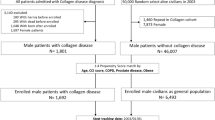Abstract
Incidence curves for the development of inguinal hernia disease and recurrences thereof exhibit a linear rise over the years and therefore suggest multi-factorial underlying causes. Several studies have revealed marked changes in the abundance and composition of interstitial collagens in patients with (recurrent) hernia diseases, adult groin hernia and incisional hernia. These observations led to the hypothesis that hernia formation and the recurrence of incisional hernia may be explained by disordered tissue renewal and by abnormal wound healing, respectively. Interstitial collagens, owing to their long half-lives and biomechanical strength, are most likely critical components of the biological system of tissue remodelling. An overview of the literature is provided, and the consequences for surgical practice are discussed.






Similar content being viewed by others
References
Statistik Bf. www.gbe-bund.de
Haapaniemi S (2006) Recurrent hernia: prevention and treatment. In: Schumpelick V (ed) Meshes: benefits and risks. Springer, Berlin Heidelberg (in press)
Flum DR, Horvath K, Koepsell T (2003) Have outcomes of incisional hernia repair improved with time? A population-based analysis. Ann Surg 237:129–135
Junqueira LC, Bignolas G, Brentani RR (1979) Picrosirius staining plus polarization microscopy, a specific method for collagen detection in tissue sections. Histochem J 11:447–455
Wirtschafter ZT, Bentley JP (1964) Hernias as a collagen maturation defect. Ann Surg 160:852–859
Wagh P, Read R (1971) Collagen deficiency in the rectus sheath of patients with inguinal herniation. Proc Soc Exp Biol Med 137:382–384
Conner WT, Peacock EE Jr (1973) Some studies on the etiology of inguinal hernia. Am J Surg 126:732–735
Nikolov S, Beltschev B (1990) Several ultrastructural peculiarities of the fascia transversalis in direct inguinal hernias of senile men. Anat Anz 170:265–272
Rodrigues AJ Jr, de Tolosa EM, de Carvalho CA (1990) Electron microscopic study on the elastic and elastic related fibres in the human fascia transversalis at different ages. Gegenbaurs Morphol Jahrb 136:645–652
Ajabnoor MA, Mokhtar AM, Rafee AA, Taha AM (1992) Defective collagen metabolism in Saudi patients with hernia. Ann Clin Biochem 29:430–436
Friedman DW, Boyd CD, Norton P, et al (1993) Increases in type III collagen gene expression and protein synthesis in patients with inguinal hernias (see comments). Ann Surg 218:754–760
Bellon JM, Bujan J, Honduvilla NG, et al (1997) Study of biochemical substrate and role of metalloproteinases in fascia transversalis from hernial processes. Eur J Clin Invest 27:510–516
Klinge U, Zheng H, Si ZY, Schumpelick V, Bhardwaj R, Klosterhalfen B (1999) Synthesis of type I and III collagen, expression of fibronectin and matrix metalloproteinases-1 and -13 in hernial sac of patients with inguinal hernia. Int J Surg Invest 1:219–227
Klinge U, Zheng H, Si Z, et al (1999) Expression of the extracellular matrix proteins collagen I, collagen III and fibronectin and matrix metalloproteinase-1 and -13 in the skin of patients with inguinal hernia. Eur Surg Res 31:480–490
Pans A (1999) New prospects in the etiology of groin hernias. Chirurgie 124:288–297
Pans A, Albert A, Lapiere CM, Nusgens B (2001) Biochemical study of collagen in adult groin hernias. J Surg Res 95:107–113
Rosch R, Klinge U, Si Z, Junge K, Klosterhalfen B, Schumpelick V (2002) A role for the collagen I/III and MMP-1/-13 genes in primary inguinal hernia? BMC Med Genet 3:2
Borquez P, Garrido L, Manterola C, et al (2003) Study of collagen and elastic fibers of connective tissue in patients with and without primary inguinal hernia. Rev Med Chil 131:1273–1279
Hosgor M, Karaca I, Ozer E, Suzek D, Ulukus C, Ozdamar A (2004) Do alterations in collagen synthesis play an etiologic role in childhood inguinoscrotal pathologies: an immunohistochemical study. J Pediatr Surg 39:1024–1029
Kayaoglu HA, Hazinedaroglu SM, Bulent Erkek A, Kocaturk PA, Kavas GO, Aribal D (2005) Comparison of the plasma and hernia sac tissue copper levels in direct and indirect inguinal hernia patients. Biol Trace Elem Res 108:53–59
Abci I, Bilgi S, Altan A (2005) Role of TIMP-2 in fascia transversalis on development of inguinal hernias. J Invest Surg 18:123–128
Taniguchi S, Ueda K, Inoue T, Li TS, Kuga T, Hamano K (2006) Impact of collagen subtype proportions in peritoneal tissues on inguinal hernia formation in adults and infants. Pediatr Surg Int 22:600–604
Boemi L, Allison G, Graham W, Krummel T, Ehrlich H (1999) Differences between scar and dermal cultured fibreoblasts derived from a patient with recurrent abdominal incision wound herniation. Plast Reconstr Surg 104:1397
Klinge U, Si ZY, Zheng H, Schumpelick V, Bhardwaj RS, Klosterhalfen B (2000) Abnormal collagen I to III distribution in the skin of patients with incisional hernia. Eur Surg Res 32:43–48
Klinge U, Si ZY, Zheng H, Schumpelick V, Bhardwaj RS, Klosterhalfen B (2001) Collagen I/III and matrix metalloproteinases (MMP) 1 and 13 in the fascia of patients with incisional hernias. J Invest Surg 14:47–54
Si Z, Bhardwaj R, Rosch R, Mertens PR, Klosterhalfen B, Klinge U (2002) Impaired balance of type I and type III procollagen mRNA in cultured fibroblasts of patients with incisional hernia. Surgery 131:324–331
Zheng H, Si Z, Kasperk R, et al (2002) Recurrent inguinal hernia: disease of the collagen matrix? World J Surg 26:401–408
Jorgensen LN (2003) Collagen deposition in the subcutaneous tissue during wound healing in humans: a model evaluation. APMIS 115 [Suppl]:1–56
Rosch R, Junge K, Lynen P, et al (2004) A case of bilateral inguinal hernia recurrence in infancy: investigations on collagen metabolism. Hernia 8:160–163
Rosch R, Junge K, Knops M, Lynen P, Klinge U, Schumpelick V (2003) Analysis of collagen-interacting proteins in patients with incisional hernias. Langenbecks Arch Surg 387:427–432
Junge K, Klinge U, Rosch R, et al (2004) Decreased collagen type I/III ratio in patients with recurring hernia after implantation of alloplastic prostheses. Langenbecks Arch Surg 389:17–22
Acknowledgements
This study was supported by the DFG KI 1320/2-1.
Author information
Authors and Affiliations
Corresponding author
Rights and permissions
About this article
Cite this article
Klinge, U., Binnebösel, M. & Mertens, P.R. Are collagens the culprits in the development of incisional and inguinal hernia disease?. Hernia 10, 472–477 (2006). https://doi.org/10.1007/s10029-006-0145-8
Published:
Issue Date:
DOI: https://doi.org/10.1007/s10029-006-0145-8




